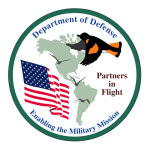Biodiversity conservation is essential in sustaining the natural landscapes required for the training and testing necessary to maintain military readiness. Managing for biodiversity can help ensure that lands and waters are maintained in a “healthy condition” and thereby facilitate greater flexibility in land use for military operations.
This document is a compilation of current best management practices and suggested focus areas to help Commanders comply with the Migratory Bird Treaty Act (MBTA), Bald and Golden Eagle Protection Act, Executive Order 13186 (Responsibilities of Federal Agencies to Protect Migratory Birds) and its associated Memorandum of Understanding, and the Final Rule on Take of Migratory Birds by the Armed Forces.
One of the best ways to comply with these legal requirements is to continue ongoing conservation efforts at the installation level. This helps protect and conserve birds and their habitats via implementation of our Integrated Natural Resources Management Plans (INRMPs), as well as to build and maintain partnerships with other agencies and conservation entities. The Department of Defense has blended conservation actions with military preparedness since the passage of the Sikes Act in 1960. By its partnering with the PIF initiative in 1991, DoD became a leader in the effort to keep common birds common.
The international PIF coalition is a partnership-based network that has expanded to include more than 300 federal and state agencies and nongovernmental organizations (NGOs) throughout the Western Hemisphere. PIF’s mission is expressed in three related concepts:
- Helping Species at Risk — protecting species before they become imperiled;
- Keeping Common Birds Common — ensuring that common native birds, both resident and migratory, remain common throughout their natural ranges; and
- Voluntary Partnerships for Birds, Habitats and People — collaborating with partners to conserve birds and their habitats.
It has long been apparent that DoD’s installations and ranges provide critical “steppingstones” of habitat for birds during their annual migrations to and from Central and South America, and valuable nesting habitat during the breeding season. DoD is thus a key partner in the PIF coalition, and the many bird conservation activities in which DoD engages are an integral part of the broader efforts in which we partner. Because of this, we call our collective bird conservation programs and activities DoD’s Partners in Flight, thus mirroring similar efforts being implemented through the National PIF network.
While our basic environmental responsibility is to wisely manage the land, water, and airspace entrusted to us, the imperative for DoD natural resource managers is to help Commanders implement their fundamental task of maintaining military readiness. While this document focuses on conserving migratory birds and their habitat via INRMPs, every goal and objective promoted here is consistent with and supportive of efforts to train military personnel by stewarding the Nation’s resources.
Current Strategic Plan
17 x 11 page size
8.5 x 11 page size
Right-click on the link above to download files to your hard drive.

